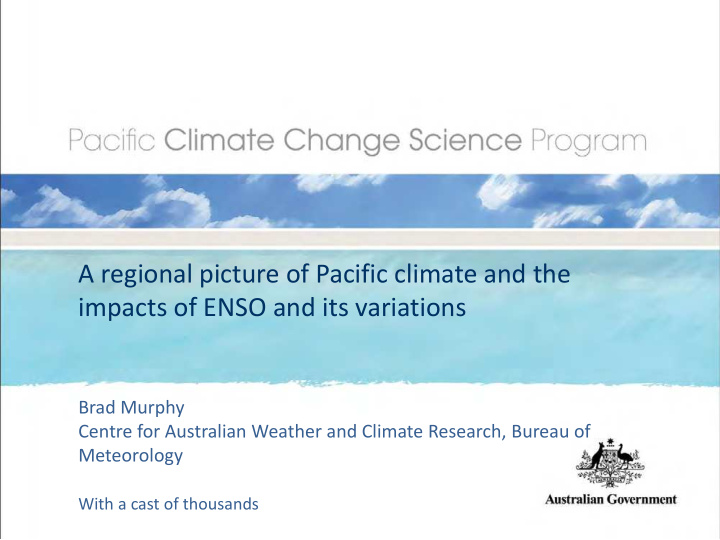



A regional picture of Pacific climate and the impacts of ENSO and its variations Brad Murphy Centre for Australian Weather and Climate Research, Bureau of Meteorology With a cast of thousands
Presentation Outline • Overview of Pacific Climate Change Science Program Regional workshops and capacity building of Met • Services • Impacts climate “features” and “drivers” on countries’ climates • Different ENSO impacts on climate
Vision statement The Pacific Climate Change Science Program (PCCSP) is a partnership between Australian science agencies and Pacific Island countries and East Timor, carried out in collaboration with Pacific regional organisations, with the objective being to conduct a comprehensive climate change science research program to provide better information about the likely impacts of climate change to stakeholders in participating countries.
PCCSP fram ew ork Understanding climate drivers: Climate data information: El Niño Southern Oscillation, Data retrieval, West Pacific Monsoon, Database management, Inter ‐ Tropical Convergence Zone, Data analysis. South Pacific Convergence Zone. Modelling and research: Climate and ocean projections for: Temperature Sea level Rainfall Currents, temperature Extreme events Ocean acidification Outputs: Scientific report and journal articles, booklets, brochures, posters; Partner country engagement, capacity building about climate science as well as climate and ocean projections.
PCCSP study region
Regional Capacity Building Workshops Vanuatu, October 2009 – Technical Workshop • • [Cairns, March 2010 – Climate and Ocean Projections Workshop] • Darwin, June 2010 ‐ Climate Data, Variability and Change Research and Training Workshop Greenhouse 2011 • • Posters from each Partner Country National Met. Service
Climate Data, Variability and Change Research and Training Workshop 54 participants from partner countries, regional agencies and Australian scientists Topics covered: Climate data management and homogenisation • • Tropical cyclone climatology • Drivers of climate variability • Methods for climate data analysis • Understanding climate models and future projections Communicating climate change •
Climate Data, Variability and Change Research and Training Workshop Outcomes: • Regional capacity in climate data management, quality control and homogenisation increased • Training provided on new data and cyclone portals Regional dataset collated suitable for analysis of • climate trends and variability • Regional capacity increased in climate analysis • Trends analysed across the region • Summaries and presentations produced describing climate, drivers, variability and trends for each country
Recent and ongoing collaboration with partner countries • Development of posters for Greenhouse 2011 • See poster session this afternoon Country Reports for each Partner Country being • written on observed climate in collaboration with NMS staff • Based on work from workshops, posters and ongoing collaboration
A new portal for the upload, analysis and visualisation of station climate data in Pacific http://www.bom.gov.au/climate/pccsp/
Summary of climate features
Main Climate Features of the region • West Pacific Monsoon • Intertropical Convergence Zone South Pacific Convergence Zone • • Extra ‐ tropical phenomena � Sub ‐ tropical highs, fronts, … • El Niño – Southern Oscillation
� May-Oct wet season � ITCZ � Strong ENSO impact � Wet La Niña � Dry El Niño � Monsoon also an influence in Palau, some years in FSM and Marshall Islands � Very weak temperature variability � controlled by SST
� Nov-April wet season � Monsoon � ENSO impact � Strong or early monsoon in La Niña years � SPCZ also influences Solomon Is. and Tuvalu � hence year-round rainfall � Very weak temperature variability � controlled by SST � plus topography in East Timor and PNG
� Nov-April wet season, but year round rainfall � Influence of ITCZ & SPCZ � ENSO impact very strong � Very wet El Niño � Very dry La Niña � Very weak temperature variability � controlled by SST
� Nov-April wet season � SPCZ � ENSO impact very strong � Dry El Niño, wet La Niña � Stronger temperature variability � controlled by SST � also extra-tropical air masses � Sub/extra-tropical influences � Sub-tropical high pressure � Cold fronts
Impacts of ENSO on country climates SST “Classic” or “Cold Tongue” ENSO “Modoki” or “Warm Pool” ENSO
RAINFALL “Classic” or “Cold Tongue” ENSO “Modoki” or “Warm Pool” ENSO Difference
Different climate impacts of ENSO variations in Partner Countries? Correlations with rainfall Modoki Correlation Nino3.4 Correlation
El Niño events La Niña events Cold Tongue El Niño events Warm Pool El Niño events
Summary PCCSP is building capacity in Pacific nations in • climate science and future climate projections, including specific training to Meteorological service staff in climate data analysis and interpretation PCCSP has gained much important information • from Pacific NMS on regional climate from existing know ‐ how and knowledge • Understanding the impacts of different ENSO events is ongoing, but some differences are evident
Recommend
More recommend